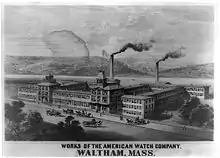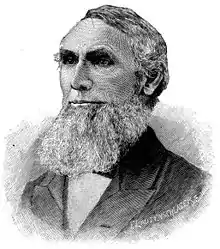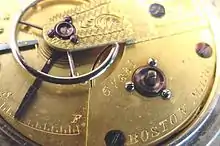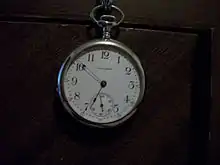Waltham Watch Company
The Waltham Watch Company, also known as the American Waltham Watch Co. and the American Watch Co., produced about 40 million watches, clocks, speedometers, compasses, time fuses, and other precision instruments between 1850 and 1957. The company's historic 19th-century manufacturing facilities in Waltham, Massachusetts have been preserved as the American Waltham Watch Company Historic District.
 | |
| Industry | Horology |
|---|---|
| Founded | 1850 |
| Defunct | 1957 |
| Headquarters | |
| Products | Watches, clocks & aircraft clocks |
History
1849 to 1853 Early history

The idea for the Waltham Watch Company came from watchmaker Aaron Lufkin Dennison. In 1833 he became a journeyman watchmaker with Currier & Trott in Boston, Massachusetts, leaving in 1839 to go into business for himself.[1] He also studied under Tubal Hone, considered the best watchmaker in America at the time. He also created the Dennison Gauge which became the "US Standard" gauge used to accurately measure different parts of watches.[1] Dennison had the idea to make watches using machinery utilizing interchangeable parts. This was to reduce the expense of repairing watches.[2]
In 1849, Dennison was approached by Edward Howard, a clock and scale maker from Boston. Howard wanted Dennison to build locomotives but instead went into business with Dennison to make watches. Initial funding of $20,000 came from venture capitalist as well as T.P. Davis, a partner of Howard.[1] Dennison began to make watch parts for the company in its "Howard & Davis" factory in 1849. A year later, the company moved to its own factory in Roxbury, Massachusetts, employing both Swiss and English watchmakers.[1] The first prototype watch was completed in 1850.[1]
The company was originally named the American Horological Company and was made up of Dennison, Howard, Davis, and Samuel Curtis. The company name was changed to Warren Manufacturing Company and released its first watch on the market in 1853.[1] The first 17 watches, which ran for 8 days, and were marked "Howard, Davis & Dennison", were distributed among company officials. Number 1, given to Howard, is now at the Smithsonian Institution. Numbers 18 to 100 were named "Warren, Boston" and the following 800 "Samuel Curtis", after the financial backer of the company. A few, marked "Fellows & Schell", sold for $40. January 1853 saw the introduction of the "P.S. Bartlett" watch, named for early employee Patten Sargent Bartlett. The company also became known as The Boston Watch Company starting in 1853.[3]
1854 to 1884; Bankruptcy and civil war

The company, known in 1854 as The Boston Watch Company, moved to Waltham, Massachusetts in 1854.[1] The investors in the company had formed The Waltham Improvement Company to purchase the land and buildings in Waltham to manufacture the watches.[3] In 1854 it produced five watches per day and employed 90 people, and was the first factory in the world to produce a pocket ready watch in the same factory.[1] Growth of the company prompted a significant expansion of these premises, whose surviving elements now date to the period 1879–1913. Now repurposed to residential and commercial use, the complex was listed on the National Register of Historic Places in 1989.
The company "failed" in 1857[3] and upon bankruptcy, it was sold at auction to Royal E. Robbins, who reorganized it under the new name Appleton Tracy & Company (ATCo) with his brother, Henry Asher Robbins. The company was sold back to The Waltham Improvement Company under a new name of The American Watch Company.[3] The next movements produced, Serial numbers 5001 to 14,000, were used in the Waltham Model 1857 watch, the first pocket watch produced in America of standard parts. The "C.T. Parker" was introduced as the 1857 model. 399 units were made. Howard left the company in 1858 to form E. Howard & Co..
In 1861, as the country entered the American Civil War, production stopped. The company decided to downsize to the lowest possible level to keep the factory open. It began producing a low cost watch called the William Ellery which was a "fad" with Union soldiers. They sold for $13 and by the end of the Civil War represented 45 percent of Waltham's sales.[4] After the Civil War, the company became the main supplier of railroad chronometers to various railroads in North America and more than fifty other countries. In 1876, the company showed off the first automatic screw making machinery and obtained the first Gold Medal in a watch precision contest at the Philadelphia Centennial Exposition.
1885 to 1957; Additional name changes and insolvency

In 1885 the company name changed to the American Waltham Watch Company (AWWCo).
In 1907 the company name changed to Waltham Watch Co. (WWCo), in 1923 briefly to the Waltham Watch and Clock Company and finally in 1925 to the Waltham Watch Company (WWC).
The company closed its factory doors and declared bankruptcy in 1949, although the factory briefly reopened a few times, primarily to finish and case existing watch inventory for sale. Several different plans were presented to restart the business, but all failed for various reasons. In 1958, the company got out of the consumer watch business completely and reorganized into the Waltham Precision Instruments Company. All remaining watch inventory had been sold to the Hallmark Watch Company the previous year, and rights to the "Waltham" trademark were sold to a new Waltham Watch Company incorporated in Delaware in exchange for stock.
1960 to 1981; Invicta by Waltham and Societe des Garde-Temps SA
Waltham was taken over in the 60’s by three brands, including Invicta.[5] There are also some Waltham watch models that have been brought to Invicta. In those years Waltham started to produce a watch line, especially for Invicta. This was called “Invicta by Waltham”. In some cases, both Invicta and Waltham were on the dial. Other cases will only show a “W” to indicate that this watch was manufactured by Waltham for Invicta.
later in the 1970s, Waltham merged into a federation with other Swiss manufacturers. The Société des Garde-Temps SA (SGT).

As a result of the quartz crisis, SGT went under in 1981 and the rights to the SGT brands were sold individually.[6]
Legacy

Before the Waltham Watch Company went out of business in 1957, it founded a subsidiary in Switzerland in 1954, Waltham International SA. Waltham International SA retains the right to the Waltham trade name outside of North America, and continues to produce mechanical wrist watches and mechanical pocket watches under the "Waltham" brand.
During their restructuring efforts in the 1950s, Waltham opened an office in New York for the purposes of importing Swiss watch movements and cases. Due to restrictions placed on the company by its main creditor, the Restructuring Finance Corporation, they could not sell these watches directly, so they were sold through an independent company, the Hallmark Watch Company.
In 1959, the Waltham Watch Company merged with the Hallmark Watch Company, giving the new company access to replacement parts to service existing Waltham watch owners. The company came under much scrutiny by the Federal Trade Commission throughout the 1960s, and ultimately was forced to change its advertising and branding policies to clearly indicate that it was not directly related to the original Waltham company, and that its products were not made in America.[7]
Specialized clocks and chronographs for use in aircraft control panels continued to be made in the Waltham factory by the Waltham Precision Instruments Company. In February 1994, Prime Time Clocks purchased the last remaining product line, the mechanical aircraft clock. Waltham Precision Instruments was moved to Ozark, Alabama and changed its name to Waltham Aircraft Clock Corporation.
Products
.jpg.webp)
Watches
Every watch movement that the company produced was engraved with an individual serial number. That number can be used to estimate the date of production. Volunteers have created a database of Waltham serial numbers,[8] models and grades,[9] and descriptions of observed watches.[10]
Two groups of high-quality watches were produced by the company for orders placed by the Canadian Pacific Railway. One large group has the shield and beaver emblem of the Railway engraved on the movements and is known as the "CPR" type. The second group has "Canadian Railway Time Service" engraved on the movements, and is known as the "CRTS" type. They are both highly prized by collectors.
Upon giving the Gettysburg Address in 1863, Abraham Lincoln was presented with a William Ellery, key wind watch Waltham Model 1857, serial number 67613. This watch is now in the collection of the National Museum of American History at the Smithsonian Institution in Washington, DC.[11]
Speedometers
The 1937 Ford sedans had Waltham speedometers, reputedly the only speedometer in a Ford to display the name of its manufacturers. A tester at the time was quoted as saying that accuracy had to be "plus or minus 10 MPH".
See also
References
- "Yankee Hod-Carrier Revolutionized the Making of Watches". The Independent-Record. 28 February 1895. Retrieved 25 August 2020.
- "Old Watches a Boston Fad". The Inter Ocean. 26 March 1901. Retrieved 25 August 2020.
- Brearley, Harry Chase (1919). Time Telling Through the Ages. Doubleday, Page & Company. p. F241-F243. ISBN 9780598742780.
In 1853 name was again changed to The Boston Watch Company, the principal stockholders of which organized The Waltham Improvement Company to buy land and buildings for The Boston Watch Company at Waltham, Massachusetts; moved into the new factory at Waltham in 1854, failed in 1857 and company's business was bought in by Royal E. Robbins, watch importer of New York City and Tracy Baker; in 1858 The Waltham Improvement Company increased its capital and purchased the business and property of The Boston Watch Company and re-incorporated under the nema of The American Watch Company; in 1855 the name was changed to The American Waltham Watch Company and in 1906 the name was again changed to The Waltham Watch Company, its present name; in 1913 the Company purchased the business of the Waltham Clock Company.
- Stephens, Carlene (29 August 2011). "A Close Look at the Pocket Watch of a Civil War Surgeon". The Atlantic. Retrieved 26 August 2020.
- Pynson, Joël (2016). Chronographs for collectors. Toulouse, France: Time To Tell. p. 205. ISBN 978-29555627-1-0.
Waltham Watch Co was bought by three Swiss companies -Avia, Invicta and Sandos, which a little later was merged with other companies to form a holding company called S.G.T. (Sociéte Garde-Temps SA).
- Treub, Lucien F. (1999). Die Zeit der Uhren. Ebner Verlag. ISBN 3871880094.
- "Waltham Precision Instruments vs Federal Trade Commission". OpenJurist. Retrieved 2010-07-16.
- Waltham serial numbers
- Waltham models and grades
- Waltham descriptions of observed watches (via Wayback Machine)
- "Abraham Lincolns Waltham Pocket Watch". Antique Time. Retrieved 2009-10-28.
Further reading
- Carosso, Vincent P., The Waltham Watch Company: A Case History, Bulletin of the Business Historical Society, Vol. 23, No. 4 (Dec., 1949), pp. 165–187, published by The President and Fellows of Harvard College
- Engle, Tom; Richard E. Gilbert; and Cooksey Shugart, Complete Guide to Watches, Twenty Seventh Edition, January 2007, ISBN 1-57432-553-1
- Edward A. Marsh (1896), The evolution of automatic machinery as applied to the manufacture of watches at Waltham, Mass., by the American Waltham Watch Co., Chicago: G. K. Hazlitt & co., OL 23704720M
- Sandburg, Carl, Lincoln Collector: The Story of Oliver R. Barrett's Great Private Collection, Harcourt, Brace and Company, 1949
- Shugart, Cooksey, The Complete Guide to American Pocket Watches, 1981, ISBN 0-517-54378-8
External links
- Official Waltham Watches Website
- Waltham Watch Company Records at Baker Library Historical Collections, Harvard Business School
- Waltham Aircraft Clock Corporation.
- Extensive collection of Waltham watches
- Historic American Engineering Record (HAER) No. MA-31, "Waltham Watch Company, 221-257 Crescent Street, Waltham, Middlesex County, MA", 1 photo, 1 data page, 1 photo caption page
- Making Watches in Waltham, 1867 New York Times article
- NAWCC: National Association of Watch & Clocks Collectors
